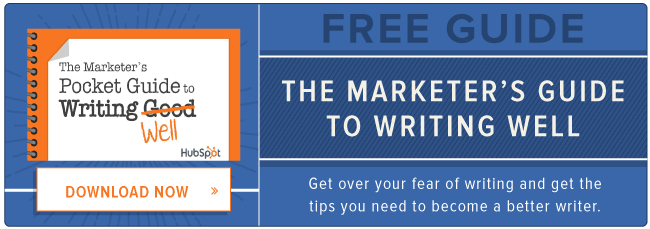
Here's the truth: There's no guarantee that anyone will actually read your writing online. You have to compel them to do that. And one way to do so is to create writing that’s effortless to consume.
Not sure where to start? That’s okay. This article will teach you the fundamentals. You'll learn how to drive audiences to read every word you write. You’ll learn how digital copywriters -- you know, marketers who use words to convert people online -- get and keep the most valuable commodity on the internet: attention.
However, in order to command an online reader’s attention, you have to first understand how they read.
The answer, of course, is that they’re not reading at all. On the internet, the majority of people are actually skimming. In fact, according to research performed by Jakob Nielsen, of the Nielsen Norman Group, only 16% of people online read word-by-word. Just about everyone else is a scanner, picking text apart for the bits that are valuable to them.
Knowing that, there are several ways you can write to make the process easier for people, ensuring that your message is entirely received.
Ready to learn a valuable skill?
How to Create Effortlessly Readable Web Writing
Jakob Nielsen holds a Ph.D. in human-computer interaction, which means he’s a foremost expert in web usability, as well as web writing. In other words, he knows how to engage internet users.
Nielsen says there are three best practices web writers should know, understand, and embrace. Here they are:
- Be concise: say everything you need to say in as few words as possible.
- Write for scanners: most people scan anyway, so why not make it easy for them?
- Use objective language: online, readers trust facts, not hype.
Below, I’ll dive deeper into each of these best practices, breaking them down and explaining their value. I’ll also prove their impact using an experiment performed by Nielsen in which he used this paragraph as a control:
Nebraska is filled with internationally recognized attractions that draw large crowds of people every year, without fail. In 1996, some of the most popular places were Fort Robinson State Park (355,000 visitors), Scotts Bluff National Monument (132,166), Arbor Lodge State Historical Park & Museum (100,000), Carhenge (86,598), Stuhr Museum of the Prairie Pioneer (60,002), and Buffalo Bill Ranch State Historical Park (28,446).
Let's start.
1) Be concise.
Many people, for whatever reason, have a tendency to bloat when they write. This bloating is the product of bad habits, which could include:
- Providing too much detail. This often happens when writers underestimate their reader’s imagination, intelligence, or base subject knowledge. The best defense against this blunder is knowing (and respecting) your audience.
- Repeating similar information in different words: There’s being verbose, and then there's being redundant. Both have no place in writing because they deliver little, if no, benefit. If you want to stave redundancy, try to keep your paragraphs to a single point or thought.
- Overusing the passive voice. Active voice (e.g., “Harry picked up the phone.”) is direct, confident, and to-the-point. Passive voice (e.g., “The phone was picked up by Harry.”), on the other hand, is weak and annoying to read. Avoid passive voice by ensuring that the subject of your sentence is doing the action, rather than being acted upon.
- Loading on the adverbs. Usually ending in -ly, adverbs modify verbs (e.g., “He spoke loudly.”). A light peppering of adverbs is fine. Overdoing it, however, could give writing the same anemic, feeble tone that passive voice conveys. Fight off adverbs by using stronger, more expressive verbs (e.g., “He clamored.”).
The issue with these actions is that they increase word count without necessarily upping the reader’s takeaway, or value. Not to mention it clutters the message, which makes text tedious and confusing to read.
Writing concisely means not using three words when two will do. It’s also as much about recognizing wordy writing in the revision stage as it is about having the ability to avoid it in the first place. Essentially, writing concisely takes editing willpower. Willpower to cut extraneous words or keep unnecessary ones out to begin with. It’s not a natural skillset by any means, but with practice and persistence it can be developed, honed, and mastered.
Here’s our control paragraph rewritten to be concise:
In 1996, six of the best-attended attractions in Nebraska were Fort Robinson State Park, Scotts Bluff National Monument, Arbor Lodge State Historical Park & Museum, Carhenge, Stuhr Museum of the Prairie Pioneer, and Buffalo Bill Ranch State Historical Park.
The Result: This version of the paragraph performed 58% better with readers than the control.
2) Write for scanners.
Nielsen’s research found that 79% of people scan web pages. That begs the question: If the majority of readers already prefer skimming, why wouldn’t you want to make it an easy, enjoyable, and efficient process for them?
Ultimately, if you want people to read your writing, you have to adjust to your audience. You have to be empathetic and courteous. It’s not about you, it’s about them. Don’t forget that.
Scannable web pages contain the following elements:
- Highlighting. Bold, italicized, colored, or hyperlinked text stands outs, which makes it more noticeable. Just don’t overdo it or the highlighting will lose its novelty and, in turn, its effect.
- Subheads. Clear, concise subheads will immediately tell scanners what they need to know -- and they’ll appreciate that. Cute, clever subheads, on the other hand, will only slow readers down.
- Bullets. Nothing breaks up text (and information) as well as bullet points and numbered lists do. Perfect for scanners who love to pluck.
- Whitespace. Blocks of text look daunting and intimidating to readers. Whitespace, like bullet points, organizes your text, giving it a more scannable and manageable appearance.
- Single-point paragraphs. Online readers -- especially if they’re researching a product or service -- are looking for takeaways. Focused, single-point paragraphs will make it easy to pick out those takeaways (while also giving you the opportunity to incorporate whitespace).
- Inverted Pyramid presentation. In academic writing, for example, students generally start with the foundation of their argument and gradually build on it until they reach the conclusion. Of course, in academia, professors are getting paid to read that stuff. No such luck with Internet audiences. That’s why web writers who start with their conclusion, and work backwards, usually have an easier time engaging impatient readers who just want to get to the point (i.e., benefits) already.
Each of these on-page elements give people something to hang their attention on, something to notice and gravitate to as they consume your content. Without them, your writing could appear too overwhelming to even begin, like the last pages of Ulysses.
Here’s our control paragraph rewritten to be scannable:
Nebraska is filled with internationally recognized attractions that draw large crowds of people every year, without fail. In 1996, some of the most popular places were:
-
Fort Robinson State Park (355,000 visitors)
-
Scotts Bluff National Monument (132,166)
-
Arbor Lodge State Historical Park & Museum (100,000)
-
Carhenge (86,598)
-
Stuhr Museum of the Prairie Pioneer (60,002)
-
Buffalo Bill Ranch State Historical Park (28,446).
The Result: This version of the paragraph performed 47% better with readers than the control.
3) Use objective language.
Online consumers hate promotional writing, or “marketese,” as Nielsen calls it. Verbiage like “makes the perfect gift ...” or “best in the universe …” is almost universally regarded as empty. So if you want to avoid sounding like a snake oil salesman and actually earn some credibility online:
- Don’t be subjective. When relaying information about a product or service, for example, be fair and balanced. Nothing is perfect. There’s always a drawback. Don’t be afraid to share it with your prospects. They’ll trust you for it.
- Don’t boast without proof. It’s okay to brag ... as long as you support your claims using facts. Hyperlinking to reputable, third-party information, for example, is a solid way to earn online clout.
- Don’t exaggerate. Your farm does not produce “The World’s Most Delicious” watermelons (and even if it did, you wouldn’t be able to prove it). It does, however, produce seedless, uber-juicy, ultra-sweet watermelons that won the Blue Ribbon at last year’s State Fair. As Farmer Hoggett once said, “That’ll do, pig. That’ll do.”
As a web writer, you don’t want the audience to feel like your copy is clearly selling them. You want the effect to be much more subtle. Ideally, you want them to feel educated and excited after they finish reading. Give them a chance to sell themselves.
Staying objective will help you achieve that scenario.
Here’s our control paragraph rewritten to be objective:
Nebraska has several attractions. In 1996, some of the most-visited places were Fort Robinson State Park (355,000 visitors), Scotts Bluff National Monument (132,166), Arbor Lodge State Historical Park & Museum (100,000), Carhenge (86,598), Stuhr Museum of the Prairie Pioneer (60,002), and Buffalo Bill Ranch State Historical Park (28,446).
The Result: This version of the paragraph performed 27% better with readers than the control.
All together now …
Yes, using these best practices individually can improve the performance of your web copy. But you won’t see spectacular results until you use all three at once.
Here’s our control paragraph rewritten to be concise and scannable and objective:
In 1996, six of the most-visited places in Nebraska were:
-
Fort Robinson State Park
-
Scotts Bluff National Monument
-
Arbor Lodge State Historical Park & Museum
-
Carhenge
-
Stuhr Museum of the Prairie Pioneer
-
Buffalo Bill Ranch State Historical Park
The Result: According to Nielsen’s study, this version of the paragraph performed a whopping 124% better with readers than the control.
Those results translate to more attention, more engagement and, of course, many more conversions. And it’s all thanks to writing that doesn’t quite feel like work when you read it.
What are your best tips for writing readable web copy? Share them in the comments below.

from HubSpot Marketing Blog http://blog.hubspot.com/marketing/create-readable-web-writing
Via http://blog.hubspot.com/marketing/create-readable-web-writing
No comments:
Post a Comment